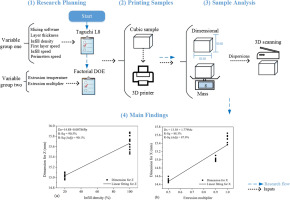当前位置:
X-MOL 学术
›
Mater. Des.
›
论文详情
Our official English website, www.x-mol.net, welcomes your feedback! (Note: you will need to create a separate account there.)
A study of parametric calibration for low cost 3D printing: Seeking improvement in dimensional quality
Materials & Design ( IF 8.4 ) Pub Date : 2017-12-01 , DOI: 10.1016/j.matdes.2017.09.020 Leonardo Santana , Jorge Lino Alves , Aurélio da Costa Sabino Netto
Materials & Design ( IF 8.4 ) Pub Date : 2017-12-01 , DOI: 10.1016/j.matdes.2017.09.020 Leonardo Santana , Jorge Lino Alves , Aurélio da Costa Sabino Netto

|
Abstract Open source projects have helped extrusion-based Additive Manufacturing processes gain popularity in recent years. While they allow the design and development of low cost machines, one of the main difficulties users have found is the parametric calibration. A study was proposed to understand the best practices for the setup of “input parameters”, since in the open software chain there are many available for setup. Through experimental design methods, the dimensional accuracy of a cubic structure was analysed by varying factors such as: slicing software, layer thickness, infill density, first layer, infill and perimeter speeds, as well as extrusion temperature and multiplier. A Prusa I3 Hephestos printer and a Polylactic Acid (PLA) filament were used, and the parts were evaluated with contact measurement, 3D scanning and mass measurement procedures. Statistical analysis showed that the dimensional accuracy of the components was mostly affected by the infill density and the extrusion multiplier. Both parameters highlight the influence of the slicing software on the planning and quality of the models. Instabilities in the amount and flow of material, characterized by excess deposition, were responsible for the distortions along the three fundamental directions of the cubes.
中文翻译:

低成本3D打印的参数校准研究:寻求尺寸质量的改进
摘要 近年来,开源项目帮助基于挤出的增材制造工艺越来越受欢迎。虽然它们允许设计和开发低成本机器,但用户发现的主要困难之一是参数校准。提出了一项研究来了解设置“输入参数”的最佳实践,因为在开放软件链中有许多可供设置。通过实验设计方法,通过各种因素分析立方结构的尺寸精度,例如:切片软件、层厚、填充密度、第一层、填充和周长速度,以及挤压温度和乘数。使用 Prusa I3 Hephestos 打印机和聚乳酸 (PLA) 灯丝,并通过接触测量对部件进行评估,3D 扫描和质量测量程序。统计分析表明,部件的尺寸精度主要受填充密度和挤压倍数的影响。这两个参数都突出了切片软件对模型规划和质量的影响。以过量沉积为特征的材料数量和流动的不稳定性是导致立方体三个基本方向变形的原因。
更新日期:2017-12-01
中文翻译:

低成本3D打印的参数校准研究:寻求尺寸质量的改进
摘要 近年来,开源项目帮助基于挤出的增材制造工艺越来越受欢迎。虽然它们允许设计和开发低成本机器,但用户发现的主要困难之一是参数校准。提出了一项研究来了解设置“输入参数”的最佳实践,因为在开放软件链中有许多可供设置。通过实验设计方法,通过各种因素分析立方结构的尺寸精度,例如:切片软件、层厚、填充密度、第一层、填充和周长速度,以及挤压温度和乘数。使用 Prusa I3 Hephestos 打印机和聚乳酸 (PLA) 灯丝,并通过接触测量对部件进行评估,3D 扫描和质量测量程序。统计分析表明,部件的尺寸精度主要受填充密度和挤压倍数的影响。这两个参数都突出了切片软件对模型规划和质量的影响。以过量沉积为特征的材料数量和流动的不稳定性是导致立方体三个基本方向变形的原因。



























 京公网安备 11010802027423号
京公网安备 11010802027423号